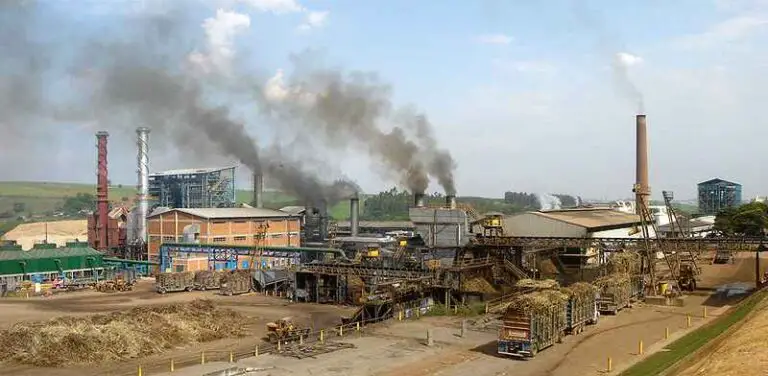5 Examples of Land Pollution Explained
Examples of land pollution are; ineffective isolation of shallow-buried nuclear waste; soil degradation by hydrocarbons, severe landfill leachate-contamination, littering with biodegradable and inorganic waste materials, and excessive chemical accumulation on agricultural land.
This article discusses the examples of land pollution, as follows;
1). Ineffective Isolation of Shallow-Buried Nuclear Waste (as one of the Examples of Land Pollution)
Nuclear waste can be buried underground as a means of short-term or long-term disposal [5].
One disadvantage of burying nuclear waste is that this increases the risk of exposure of such waste to soil and groundwater resources.
Electromagnetic radiation can be very hazardous to living organisms (plants and animals including humans) when these are exposed to such radiation.
Dangers of buried nuclear waste are all traceable to the toxicity of radioactive materials like uranium and plutonium, which are dominant constituents of such waste, and pose a threat to agriculture, aquatic ecosystems and terrestrial biodiversity.
Nuclear waste is a potential cause of land pollution when it is not effectively isolated from the environment using soil-protective liners and corrosion-resistant vessels.
The potential severity of land pollution by buried nuclear waste depends on a variety of factors.
One of these is the depth of burial; where shallower burial-depths are associated with higher risk of subsequent pollution.
Another factor that determines severity of radioactive-land pollution is the grade or type of nuclear waste involved.
The three types of nuclear waste are low-level, intermediate-level and high-level nuclear wastes [6].
Low-level nuclear waste is less hazardous than high-level nuclear waste; meaning that the effects of exposure to high-level nuclear waste on a given land area, are likely to be more severe than the effects of exposure to low-level waste.
Environmental issues involving land pollution-risk from radioactive materials, are most prominent in areas surrounding nuclear power plants or radioactive mines; where the environmental impacts of nuclear materials and activities are most pronounced.

2). Soil Degradation by Hydrocarbons
Hydrocarbons can cause soil pollution or degradation when they are deposited in excessive quantity, on a given land area.
Sources of hydrocarbon pollution include oil spills from tankers, automobile engine oil leaks, and industrial chemical outlets. These sources can release hydrocarbon pollutants into land to cause degradation.
Hydrocarbons affect soil immensely by clogging pores for aeration, reducing soil microbe populations, altering soil structure, and having a toxic effect on the chemical composition of the soil.
The severity of hydrocarbons' toxic effect on the soil is compounded by processes like dispersion, migration, leaching, and volatilization; which cause pollutants in soil to spread across a larger area and into the atmosphere and hydrosphere, causing air and water pollution respectively.
Soil degradation by hydrocarbons is a relatively-prominent environmental issue in petroleum-rich zones with active drilling, refining and transport activities.
Efforts to achieve remediation of polluted sites have led to the understanding of various processes that determine the fate of hydrocarbon pollutants in soil, such as; photo-oxidation, biodegradation and dissolution [1].
Among these, biodegradation by microbes can be used as a technique for reducing or totally eliminating hydrocarbon pollutants (called microbial-bioremediation) [9]. This method often involves deliberate addition of nutrients to the soil to stimulate microbe growth; a practice known as landfarming [4].
3). Severe Landfill Leachate-Contamination (as one of the Examples of Land Pollution)
Leachate is a term used to describe the toxic fluid produced from decomposition of organic waste matter in landfills.
Leachate contamination describes the process by which leachate migrates from the point of it formation in a landfill, into adjacent areas which could include soils and groundwater reserves.
Landfill leachate affects the environment in a negative manner, by decreasing soil and water quality.
The effect of landfill leachate on soil includes structural, biogenic and physicochemical changes, which accompany the accumulation of contaminants in affected soils.
The two major contaminants in landfill leachate are; heavy metals like lead, chromium, copper, cadmium and nickel [8]; and organic pollutants; like bacteria.
Land pollution cases that involve leachate are often severe, featuring high contamination levels and affecting groundwater, vegetation and soil [3]. Physicochemical analyses are often used to determine the degree of severity [7], which is useful when making remediation-related decisions.
4). Littering with Biodegradable and Inorganic Waste Materials
Materials that cause land pollution are organic and inorganic pollutants, which often come from waste that is indiscriminately disposed or improperly managed.
The difference between organic and inorganic pollutants is based on their sources and physicochemical characteristics, where organic pollutants come from biomass, living organisms and biological processes; while inorganic pollutants originate from abiotic sources and processes.
Inorganic pollutants include plastics, which are a major cause of littering in urban areas; also referred to as urban plastic pollution.
Organic waste affects the environment by encouraging the growth and spread of harmful pathogens, along with toxic organic compounds in soil, water and air. Littering with organic waste (often in the form of food materials) is a cause of land pollution in areas that have been subjected to urbanization and overpopulation, with poor waste management structures.

5). Excessive Chemical Accumulation (as one of the Examples of Land Pollution)
Land pollution can be caused by the accumulation of chemical with hazardous tendencies, in soil.
Chemicals cause land pollution by altering the balance of elements and nutrients in surface soil and water, to such an extent that becomes harmful to living organisms.
Some chemical constituents involved in land pollution are; polynuclear aromatic hydrocarbons (PAHs) like benzopyrene; phosphates from agricultural fertilizer; and heavy metals like lead. These compounds are known to affect soil, surface water and groundwater resources.
Soil pollution is caused by excessive use of chemical fertilizers because these chemicals, when accumulated in high concentrations, tend to alter soil characteristics like pH, acidity and oxygen content; and can reduce the biological productivity of the soil [2].
Heavy metals are particularly hazardous when they accumulate in soil, as these elements and their compounds can be taken up by growing crops, thereby posing a risk to consumers [10]. This mechanism (of pollutant uptake by plants) is described using various terms such as phytoremediation, phytoextraction and phytoaccumulation, and can be used deliberately as a means of pollutant-removal, as illustrated in the image below;

Conclusion
Examples of land pollution are;
1. Ineffective Isolation of Shallow-Buried Nuclear Waste
2. Soil Degradation by Hydrocarbons
3. Severe Landfill Leachate-Contamination
4. Littering with Biodegradable and Inorganic Waste Materials
5. Excessive Chemical Accumulation
References
1). Ambaye, T. G.; Chebbi, A.; Formicola, F.; Prasad, S.; Gomez, F. H.; Franzetti, A.; Vaccari, M. (2022). "Remediation of soil polluted with petroleum hydrocarbons and its reuse for agriculture: Recent progress, challenges, and perspectives." Chemosphere. 2022 Apr;293:133572. Avalable at: https://doi.org/10.1016/j.chemosphere.2022.133572. (Accessed 5 May 2023).
2). Bisht, N.; Chauhan, P. S. (2020). "Excessive and Disproportionate Use of Chemicals Cause Soil Contamination and Nutritional Stress." Soil Contamination. Available at: https://doi.org/10.5772/intechopen.94593. (Accessed 6 May 2023).
3). Hredoy, R. H.; Siddique, A. B.; Akbor, A.; Rahman, M. (2022). "Impacts of Landfill Leachate on the Surrounding Environment: A Case Study on Amin Bazar Landfill, Dhaka (Bangladesh)." Soil Systems 6(4):90. Available at: https://doi.org/10.3390/soilsystems6040090. (Accessed 5 May 2023).
4). Kanwal, M.; Ullah, H.; Gulzar, A.; Sadiq, T.; Sarfaz, M.; Aslam, M. W.; Khan, N. N.; Batool, T.; Maqsood, S.; Nawaz, A. Ullah, M. (2022). "Biodegradation of Petroleum Hydrocarbons and The Factors Effecting Rate of Biodegradation." American Journal of Biomedical Science & Research. Available at: https://doi.org/10.34297/AJBSR.2022.16.002182. (Accessed 5 May 2023).
5). Kim, J-S.; Kwon, S.; Sánchez, M.; Cho, G-C. (2011). "Geological Storage of High Level Nuclear Waste." Journal of Civil Engineering 15(4):721-737. Available at: https://doi.org/10.1007/s12205-011-0012-8. (Accessed 6 May 2023).
6). Liu, J.; Dai, W. (2019). "Overview of nuclear waste treatment and management." E3S Web of Conferences 118(1):04037. Available at: https://doi.org/10.1051/e3sconf/201911804037. (Accessed 6 May 2023).
7). Parvin, F.; Tareq, S. M. (2021). "Impact of landfill leachate contamination on surface and groundwater of Bangladesh: a systematic review and possible public health risks assessment." Appl Water Sci. 2021;11(6):100. Available at: https://doi.org/10.1007/s13201-021-01431-3. (Accessed 5 May 2023).
8). Salam, M.; Mattu, N. N. (2021). "Hazardous Components of Landfill Leachates and Its Bioremediation." Soil Contamination. Available at: https://doi.org/10.5772/intechopen.94890. (Accessed 5 May 2023).
9). Stepanova, A. Y.; Gladkov, E.A.; Osipova, E. S.; Gladkova, O. V.; Tereshonok, D. V. (2022). "Bioremediation of Soil from Petroleum Contamination." Processes 2022, 10, 1224. Available at: https://doi.org/10.3390/pr10061224. (Accessed 5 May 2023).
10). Zwolak, A.; Sarzyńska, M.; Szpyrka, E.; Stawarczyk, K. (2019). "Sources of Soil Pollution by Heavy Metals and Their Accumulation in Vegetables: a Review." Springer, Water Air and Soil Pollution 230(7). Available at: https://doi.org/10.1007/s11270-019-4221-y. (Accessed 5 May 2023).





